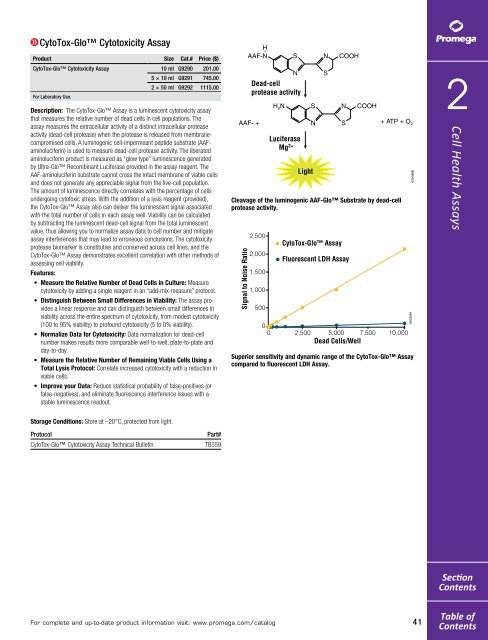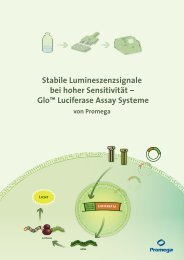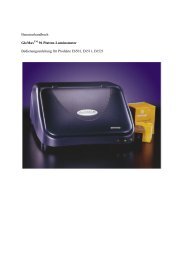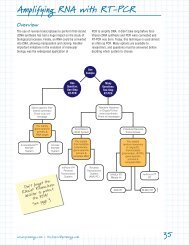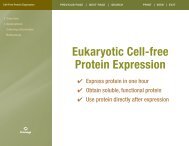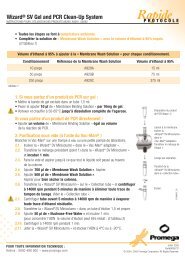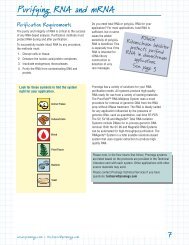- Page 1 and 2: Life Science CATALOG 2012
- Page 3 and 4: Cell Signaling Table of Contents Pr
- Page 5 and 6: Cell Signaling 1 Biochemicals and L
- Page 7 and 8: Cell Signaling Agarose, LMP, Prepar
- Page 9 and 10: Cell Signaling Blue/Orange Loading
- Page 11 and 12: Cell Signaling Glycine, Molecular B
- Page 13 and 14: Cell Signaling Sephacryl ® S-400 P
- Page 15 and 16: Cell Signaling Tris Base, Molecular
- Page 17 and 18: Cell Signaling Unmethylated Lambda
- Page 19 and 20: Cell Signaling Promega Barrier Tips
- Page 21 and 22: Cell Signaling Product Size Cat.# P
- Page 23 and 24: Cell Signaling 2 Cell Health Assays
- Page 25 and 26: Cell Signaling A. B. Luminescence/p
- Page 27 and 28: Cell Signaling Luminogenic Enzyme S
- Page 29 and 30: Cell Signaling Apoptosis
- Page 31 and 32: Cell Signaling Caspase-Glo ® 2 Ass
- Page 33 and 34: Cell Signaling Caspase-Glo ® 9 Ass
- Page 35 and 36: Cell Signaling CaspACE Assay System
- Page 37 and 38: Cell Signaling Anti-ACTIVE ® Caspa
- Page 39 and 40: Cell Signaling BacTiter-Glo Microbi
- Page 41 and 42: Cell Signaling CellTiter 96 ® AQ u
- Page 43: Cell Signaling MultiTox-Fluor Multi
- Page 47 and 48: Cell Signaling CytoTox 96 ® Non-Ra
- Page 49 and 50: Cell Signaling GSH-Glo Glutathione
- Page 51 and 52: Cell Signaling 3 Cell Signaling 3 G
- Page 53 and 54: Cell Signaling cAMP-Glo Max Assay P
- Page 55 and 56: Cell Signaling Growth Factors Epide
- Page 57 and 58: Cell Signaling SIRT-Glo Assays and
- Page 59 and 60: Cell Signaling ADP-Glo Max Assay Pr
- Page 61 and 62: Cell Signaling Kinase Enzyme System
- Page 63 and 64: Cell Signaling Kinase Enzyme System
- Page 65 and 66: Cell Signaling Kinase-Glo ® Lumine
- Page 67 and 68: Cell Signaling SignaTECT ® Protein
- Page 69 and 70: Cell Signaling Casein Kinase I Prod
- Page 71 and 72: Cell Signaling Product Size Cat.# P
- Page 73 and 74: Cell Signaling Protein Kinase Subst
- Page 75 and 76: Cell Signaling 4 Cloning and DNA Ma
- Page 77 and 78: Cell Signaling DNA Step Ladders Pro
- Page 79 and 80: Cell Signaling Conventional DNA Mar
- Page 81 and 82: Cell Signaling ProMega-Markers ® L
- Page 83 and 84: Cell Signaling Restriction Enzymes
- Page 85 and 86: Cell Signaling BamHI 37 Product Siz
- Page 87 and 88: Cell Signaling EcoRI 37 Product Siz
- Page 89 and 90: Cell Signaling NciI 37 Product Size
- Page 91 and 92: Cell Signaling SpeI 37 Product Size
- Page 93 and 94: Cell Signaling TSAP Thermosensitive
- Page 95 and 96:
Cell Signaling T3 RNA Polymerase Pr
- Page 97 and 98:
Cell Signaling Kinases T4 Polynucle
- Page 99 and 100:
Cell Signaling S1 Nuclease Product
- Page 101 and 102:
Cell Signaling Percent Inhibition o
- Page 103 and 104:
Cell Signaling Untagged Flexi ® Ma
- Page 105 and 106:
Cell Signaling pGEM ® -5Zf(+) Vect
- Page 107 and 108:
Cell Signaling pSP64 Poly(A) Vector
- Page 109 and 110:
Cell Signaling 5 DNA and RNA Purifi
- Page 111 and 112:
Cell Signaling x-tracta Gel Extract
- Page 113 and 114:
Cell Signaling Wizard ® MagneSil
- Page 115 and 116:
Cell Signaling ReliaPrep FFPE gDNA
- Page 117 and 118:
Cell Signaling MagneSil ® ONE, Fix
- Page 119 and 120:
Cell Signaling MagneSil ® KF, Geno
- Page 121 and 122:
Cell Signaling Plasmid Purification
- Page 123 and 124:
Cell Signaling PureYield Plasmid Ma
- Page 125 and 126:
Cell Signaling Wizard ® Plus Maxip
- Page 127 and 128:
Cell Signaling Wizard ® MagneSil
- Page 129 and 130:
Cell Signaling PureYield RNA Midipr
- Page 131 and 132:
Cell Signaling Maxwell ® 16 System
- Page 133 and 134:
Cell Signaling RNasin ® Plus RNase
- Page 135 and 136:
Cell Signaling DNA Quantitation Qua
- Page 137 and 138:
Cell Signaling Magnetic Stands and
- Page 139 and 140:
Cell Signaling 6 Drug Discovery 6 D
- Page 141 and 142:
Cell Signaling GPCR Assays cAMP-Glo
- Page 143 and 144:
Cell Signaling PDE-Glo Phosphodiest
- Page 145 and 146:
Cell Signaling Protease Assays Prot
- Page 147 and 148:
Cell Signaling Cell-Based Proteasom
- Page 149 and 150:
Cell Signaling Tryptase, Human, Rec
- Page 151 and 152:
Cell Signaling 7 Genetic Identity 7
- Page 153 and 154:
Cell Signaling Maxwell ® 16 Forens
- Page 155 and 156:
Cell Signaling Plexor ® HY System
- Page 157 and 158:
Cell Signaling PowerPlex ® 18D Sys
- Page 159 and 160:
Cell Signaling PowerPlex ® CS7 Sys
- Page 161 and 162:
Cell Signaling PowerPlex ® 16 and
- Page 163 and 164:
Cell Signaling GenePrint ® Fluores
- Page 165 and 166:
Cell Signaling 8 Imaging and Immuno
- Page 167 and 168:
Cell Signaling HaloTag ® Ligand Bu
- Page 169 and 170:
Cell Signaling Block & Sample 5X Bu
- Page 171 and 172:
Cell Signaling Anti-ACTIVE ® JNK p
- Page 173 and 174:
Cell Signaling Anti-ERK 1/2 pAb, Ra
- Page 175 and 176:
Cell Signaling Anti-Human GDNF pAb
- Page 177 and 178:
Cell Signaling Anti-PARP p85 Fragme
- Page 179 and 180:
Cell Signaling Anti-VAChT pAb Produ
- Page 181 and 182:
Cell Signaling VivoGlo Caspase 3/7
- Page 183 and 184:
Cell Signaling 9 Industrial and Env
- Page 185 and 186:
Cell Signaling Microbial Detection
- Page 187 and 188:
10 Instruments 10 Luminometers 184
- Page 189 and 190:
GloMax ® 20/20 Luminometer Product
- Page 191 and 192:
Fluorescence Module: Application-op
- Page 193 and 194:
GloMax ® -Multi Jr Single-Tube Mul
- Page 195 and 196:
Maxwell ® 16 Instruments Maxwell
- Page 197 and 198:
Maxwell ® 16 Flexi Method Firmware
- Page 199 and 200:
Cell Signaling 11 Molecular Diagnos
- Page 201 and 202:
Cell Signaling Maxwell ® 16 System
- Page 203 and 204:
Cell Signaling Maxwell ® 16 Flexi
- Page 205 and 206:
Cell Signaling dNTP Mix Product Siz
- Page 207 and 208:
Cell Signaling 12 PCR 12 Hot-Start
- Page 209 and 210:
Cell Signaling TaqBead Hot Start Po
- Page 211 and 212:
Cell Signaling GoTaq ® PCR Core Sy
- Page 213 and 214:
Cell Signaling Deoxynucleotide Trip
- Page 215 and 216:
Cell Signaling Plexor ® qPCR and q
- Page 217 and 218:
Cell Signaling StemElite Differenti
- Page 219 and 220:
Cell Signaling Reverse Transcriptio
- Page 221 and 222:
Cell Signaling AMV Reverse Transcri
- Page 223 and 224:
Cell Signaling PCR Cloning pGEM ®
- Page 225 and 226:
Cell Signaling 13 Protein Expressio
- Page 227 and 228:
Cell Signaling TnT ® Quick Coupled
- Page 229 and 230:
Cell Signaling TnT ® T7 Quick for
- Page 231 and 232:
Cell Signaling Canine Pancreatic Mi
- Page 233 and 234:
Cell Signaling pGEM ® β-Gal Contr
- Page 235 and 236:
Cell Signaling Immobilized Trypsin
- Page 237 and 238:
Cell Signaling Asp-N, Sequencing Gr
- Page 239 and 240:
Cell Signaling HaloTag ® Ligand Bu
- Page 241 and 242:
Cell Signaling Inducible T7-Driven
- Page 243 and 244:
Cell Signaling ProtoBlot ® II AP S
- Page 245 and 246:
Cell Signaling 14 Protein Purificat
- Page 247 and 248:
Cell Signaling HaloTag ® Protein P
- Page 249 and 250:
HT Cell Signaling HaloTag ® Mammal
- Page 251 and 252:
Cell Signaling HaloLink Protein Arr
- Page 253 and 254:
Cell Signaling HaloCHIP System Prod
- Page 255 and 256:
Cell Signaling MagneHis Protein Pur
- Page 257 and 258:
Cell Signaling Streptavidin Product
- Page 259 and 260:
Cell Signaling Protein Purification
- Page 261 and 262:
Cell Signaling 15 Reporter Assays a
- Page 263 and 264:
Cell Signaling Dual-Glo ® Lucifera
- Page 265 and 266:
Cell Signaling Firefly Luciferase R
- Page 267 and 268:
Cell Signaling Bright-Glo Luciferas
- Page 269 and 270:
Cell Signaling EnduRen Live Cell Su
- Page 271 and 272:
Cell Signaling Beta-Glo ® Assay Sy
- Page 273 and 274:
Cell Signaling Promoter-Driven Cont
- Page 275 and 276:
Cell Signaling Nuclear Receptor Pat
- Page 277 and 278:
Cell Signaling pRL Renilla Lucifera
- Page 279 and 280:
Cell Signaling GloResponse Lucifera
- Page 281 and 282:
Cell Signaling pSP-luc+NF Fusion Ve
- Page 283 and 284:
Cell Signaling VivoGlo Caspase 3/7
- Page 285 and 286:
Cell Signaling Transfection Reagent
- Page 287 and 288:
Cell Signaling 16 RNA Analysis 16 I
- Page 289 and 290:
Cell Signaling Riboprobe ® System
- Page 291 and 292:
Cell Signaling HeLaScribe ® Nuclea
- Page 293 and 294:
Cell Signaling RNA Interference Gen
- Page 295 and 296:
Cell Signaling 17 Stem Cell Researc
- Page 297 and 298:
Cell Signaling Cell ID System Produ
- Page 299 and 300:
Cell Signaling StemElite Human Panc
- Page 301 and 302:
Cell Signaling 18 Vectors 18 Expres
- Page 303 and 304:
Cell Signaling HaloTag ® Fusion (N
- Page 305 and 306:
Cell Signaling pCI Mammalian Expres
- Page 307 and 308:
Cell Signaling Reporter Vectors pGL
- Page 309 and 310:
Cell Signaling pGEM ® -luc DNA Pro
- Page 311 and 312:
Cell Signaling pGEM ® and pSP Subc
- Page 313 and 314:
Cell Signaling pUC/M13 Sequencing P
- Page 315 and 316:
Index: A-Z 19 Index 19 Index: A-Z 3
- Page 317 and 318:
Index: A-Z BssHII..................
- Page 319 and 320:
Index: A-Z In vitro Transcription S
- Page 321 and 322:
Index: A-Z QuantiFluor dsDNA System
- Page 323 and 324:
Index by Catalog Number Cat# Produc
- Page 325 and 326:
Index by Catalog Number Cat# Produc
- Page 327 and 328:
Index by Catalog Number Cat# Produc
- Page 329 and 330:
Index by Catalog Number Cat# Produc
- Page 331 and 332:
Index by Catalog Number Cat# Produc
- Page 333 and 334:
Index by Catalog Number Cat# Produc
- Page 335 and 336:
Index by Catalog Number Cat# Produc
- Page 337 and 338:
Index by Catalog Number Cat# Produc
- Page 339 and 340:
Index by Catalog Number Cat# Produc
- Page 341 and 342:
Index by Catalog Number Cat# Produc
- Page 343 and 344:
Index by Catalog Number Cat# Produc
- Page 345 and 346:
Index by Catalog Number Cat# Produc
- Page 347 and 348:
personal detection GloMax Integrat


